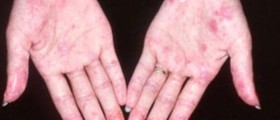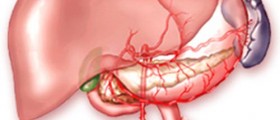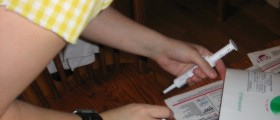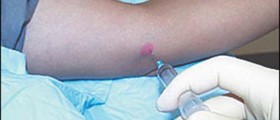
Pyoderma gangrenosum is a condition characterized by necrosis of the affected tissue and formation of deep ulcers. These lesions are most frequently located on the lower extremities. Once the ulcers develop, they may progress into chronic wounds. The condition is not lethal. However, it can be quite debilitating and painful, also leading to severe scarring.
Who's at Risk?
It is estimated that 1 person in 100,000 develops pyoderma gangrenosum. The disease affects people of any age with the peak incidence in individuals in their 40s and 50s.
Pyoderma Grangrenosum Types
Pyoderma gangrenosum can be classified into typical, ulcerative disease that affects the legs and atypical form characterized by more superficial lesions that predominantly develop on the hands and other parts of the body. Apart from this classification, there are several more variants of the disease including peristomal pyoderma gangrenosum, bullous pyoderma gangrenosum, pustular pyoderma gangrenosum and vegetative pyoderma gangrenosum.
Pyoderma Gangrenosum Causes
The actual cause of pyoderma is a mystery. Still, the condition is believed to be closely associated with the immune system dysfunction. Namely, the disease is the consequence of improper functioning of neutrophils.
Furthermore, approximately half of all patients with pyoderma gangrenous also suffer from some other medical conditions like Crohn's disease, ulcerative colitis, rheumatoid arthritis and multiple myeloma.
Scientists have additionally confirmed that the condition occurs more if there is some major or minor trauma to the skin.
Pyoderma Gangrenosum Treatment
Both disseminated disease and localized skin changes are treated with corticosteroids or Cyclosporine. If the treatment does not provide with desirable results, patients are administered a combination of corticosteroids with mycophenolate mofetil, Cyclosporine and mycophenolate mofetil and there are several more medications which can be used alternatively (tacrolimus, thalidomide or infliximab). One more treatment modality for pyoderma gangrenosum is plasmapheresis.
Surgery is generally not considered a suitable treatment option for such patients. The explanation is rather simple. As it has already been said, ulcers are induced by major/minor trauma, so if the one undergoes surgery (which is supposed to be corrective) this may induce even more scarring and worsen the already existing ulcers. The only surgical procedure doctors may opt for is careful removal of necrotic tissue. Once the affected skin has recovered, patients may think about skin grafting. This surgical procedure is basically performed if ulcers are huge and cannot heal spontaneously.
Pyoderma Gangrenosum Prevention
There is no way to prevent this medical condition. If the scientists manage to identify the underlying cause, they may be able to propose efficient means of prevention. Until then, the only things patients are left with is treatment they are due to follow according to doctor's orders and skin trauma and injuries they are supposed to avoid as much as possible.

















Your thoughts on this
Loading...